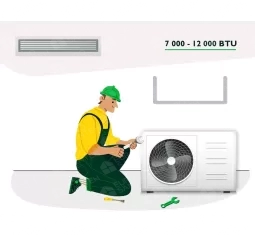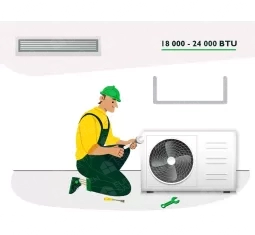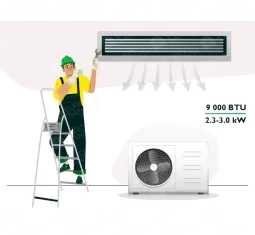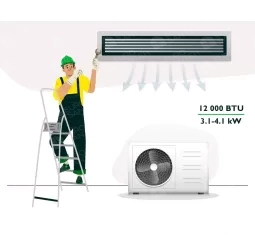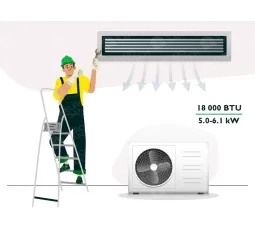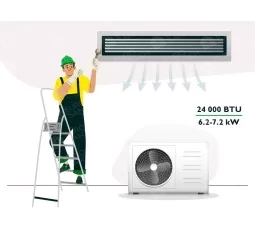Installation of duct air conditioners in Chisinau
Duct air conditioners represent one of the most efficient systems for climate control in large spaces and buildings. These systems ensure the uniform distribution of cooled or heated air throughout the entire area, creating a comfortable environment for both residential and commercial spaces. The installation of duct air conditioners requires a professional approach, as it involves numerous technical details and specifications that must be considered to achieve maximum system efficiency.
Advantages of Duct Air Conditioners
The primary advantage of duct air conditioners is their concealed installation. Unlike split systems that are mounted on walls and remain visible, duct air conditioners are hidden behind suspended ceilings or false walls. This preserves the aesthetics of the interior and avoids the placement of visible units and pipes.
Additionally, duct systems are highly powerful and can service large areas, making them ideal for use in office buildings, shopping centers, hotels, and private homes. They ensure the even distribution of air across all rooms, which is particularly important for maintaining a comfortable microclimate.
Preparation for the Installation of Duct Air Conditioners
Before starting the installation of duct air conditioners, a thorough inspection of the space must be conducted, and a detailed project plan must be created. This plan should include parameters such as the area and layout of the rooms, the number and placement of air ducts, and the capacity of the equipment. These data are essential for selecting the appropriate air conditioning system and ensuring its efficient operation.
Special attention should be given to choosing the location for the installation of indoor and outdoor units. The indoor unit is typically mounted in the ceiling space or behind a false wall, while the outdoor unit is installed outside the building, on the roof, or on a balcony. It is crucial to ensure easy access to both units for maintenance and repair.
Stages of Installing Duct Air Conditioners
The installation of duct air conditioners involves several stages, each requiring precise adherence to technologies and standards.
Mounting Indoor and Outdoor Units: In the first stage, the indoor and outdoor units of the system are installed. The indoor unit is secured in the pre-prepared location, while the outdoor unit is placed on a specially equipped platform, considering ventilation and noise reduction requirements.
Laying Air Ducts: After the units are installed, the next step is laying the air ducts. The ducts can be made from various materials, such as galvanized steel or aluminum, and must be securely fixed. It is important to correctly calculate their diameter and length to ensure optimal air distribution throughout all rooms.
Connecting the System to the Electrical Network: The next stage is connecting the system to the electrical network. This must be done by qualified specialists, as any irregularities can lead to equipment malfunctions and even fires. It is also necessary to install a separate circuit breaker to protect the system from overloads.
System Setup and Start-Up: After completing all installation work, the system is set up. Specialists check the tightness of connections, the correct operation of all components and assemblies, and perform the initial start-up of the system. It is important to ensure that all elements are working correctly and that the system efficiently cools or heats the air.
Maintenance of Duct Air Conditioners
Proper installation of duct air conditioners is only part of the process. To ensure the system operates efficiently and lasts a long time, regular maintenance is required. The main types of maintenance include:
- Cleaning Filters: Filters trap dust and other impurities, so they need to be cleaned or replaced regularly. This not only improves air quality but also extends the equipment's lifespan.
- Checking Air Ducts: Air ducts should be airtight and clean. They need to be periodically inspected for damage and contamination.
- Monitoring Operating Characteristics: Regularly check the system's operating characteristics, such as pressure, temperature, noise level, etc. This helps in timely identifying and fixing malfunctions.
- Professional Servicing: It is recommended to invite specialists once a year to perform comprehensive system maintenance. They will check all components and assemblies, make necessary adjustments, and replace worn parts.
Conclusion
The installation of duct air conditioners is a complex process that requires a professional approach and thorough knowledge. Proper selection of equipment, strict adherence to installation technologies, and regular maintenance ensure the efficient operation of the system and a comfortable microclimate in the space. Therefore, the installation and maintenance of duct air conditioners should only be entrusted to qualified specialists with the experience and necessary skills.
Duct air conditioners offer a blend of efficiency, aesthetic appeal, and powerful performance, making them a preferred choice for large-scale climate control solutions. By ensuring meticulous planning and execution, these systems can provide unparalleled comfort and reliability in diverse environments.
